- Job Seeker Statistics
- Career Change statistics
- Internship Statistics
- Job Search Statistics
- Average Number Of Jobs Applied
- Average Salary Increase When Changing Jobs
- Part Time Job Statistics
- Age Discrimination Statistics
- Networking Statistics
- Interview Statistics
- Average Number of Jobs In A Lifetime
- Resume Statistics
- Side Hustle Statistics
- Teacher Statistics
Research Summary: With so many jobs filled by personal and professional connections, it’s easy to see that Americans underestimate the power of networking. The fact is that a majority of employees wouldn’t have gotten to where they are today without it.
To find out more about the topic, we’ve gathered all of the most essential facts about networking business, as well as networking statistics. According to our extensive research:
-
85% of jobs are filled via networking with personal and professional connections.
-
Up to 70% of employees received their current company position through networking.
-
68% of individuals prefer networking in person rather than virtually, and 95% of professionals agree that face-to-face connections are key for successful long-term business relationships.
-
Despite the importance of networking, only 48% of people report that they keep in touch with their network.
-
49% of people who don’t maintain contact with their network said they don’t have enough time for networking.
-
79% of Americans agree that networking plays a vital role in their career progression.
-
41% of professionals would like to attend networking events more often.
For further analysis, we broke down the data in the following ways:
Career Success | In-person Networking | Virtual Networking | Networking Challenges | Demographics
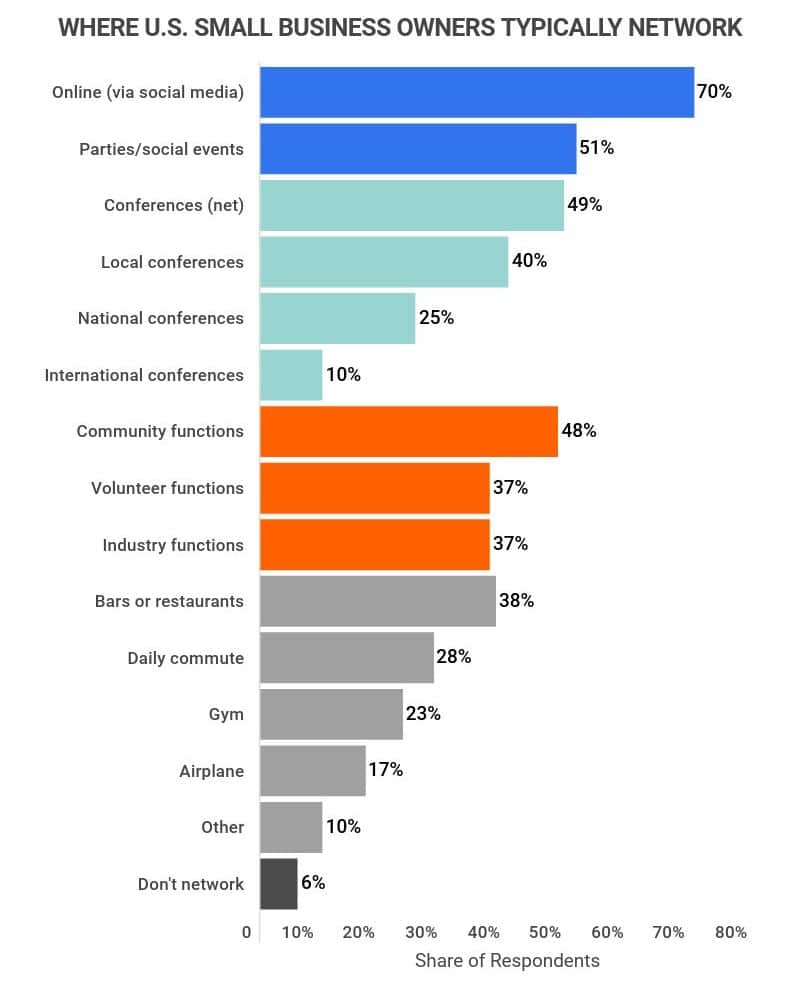
General Networking Statistics
To get an idea of how networking affects workers and how it makes a massive, positive impact, we’ve gathered some general facts about it. Our research has shown that networking is vital for landing a job, as well as career progression. Here are the facts:
-
70% of people got their current job through networking.
This can be attributed to the fact that 80% of jobs aren’t even listed on job sites. Overall, networking proves to be far more important than other job-search methods, at a rate of seven to one.
-
57% of people report that having a business card is essential for business networking.
This is backed up by the fact that 72% of people judge a company based on the quality of their business card, and 39% of people would choose not to do business with a company that has a “cheap-looking” business card.
-
Data shows that networking emails with the highest rate of engagement are sent between 9 and 11 a.m.
53% of networking emails sent during this time frame are read, with a peak being at 10 a.m.
-
Employee referrals account for 40% of all hires.
Despite employee referrals only making up 7% of the candidates who apply, they result in a staggering 40% of hires. That’s significant, considering that 62% of interviews come from job boards and other employment websites.
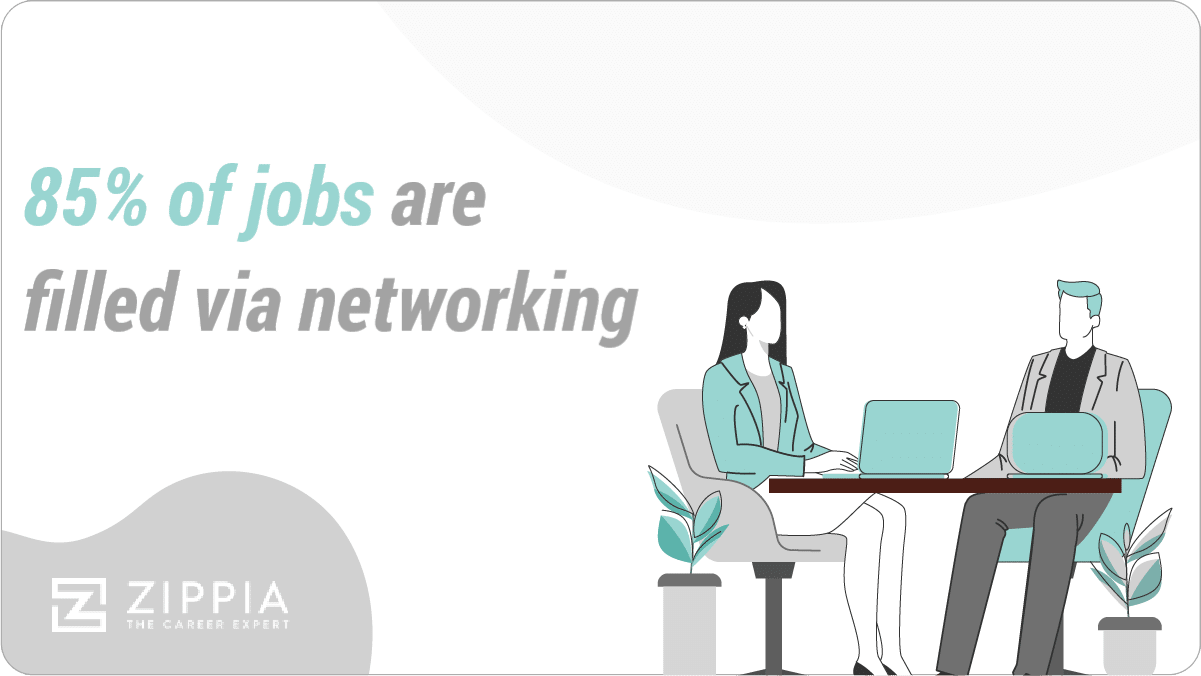
Networking Statistics by Career Success
Networking is a valuable part of your career, and everyone from business owners to customers knows it. 79% of people agree that networking plays a vital role in their career progression, and 40% of prospects become new customers after a face-to-face meeting. Here are the insights our research has uncovered:
-
79% of professionals believe that career success depends on networking.
A vast majority of people understand the value of networking, whether online or in person. Despite this, only 48% say they keep in touch with their network due to a lack of time and other factors.
-
Networking is responsible for the success of 78% of startups.
Networking plays a key role for entrepreneurs, and online networking is especially common. Of different websites, Linkedin and Facebook are most commonly used for networking, with Linkedin used by 56% and Facebook used by 37% of entrepreneurs.
-
40% of prospects become new customers after a face-to-face meeting, compared to only 16% without.
Face-to-face meetings are an important part of successful businesses, as professionals are 24% more likely to gain customers from them. Plus, a considerable 27% of current business would be lost without in-person meetings.
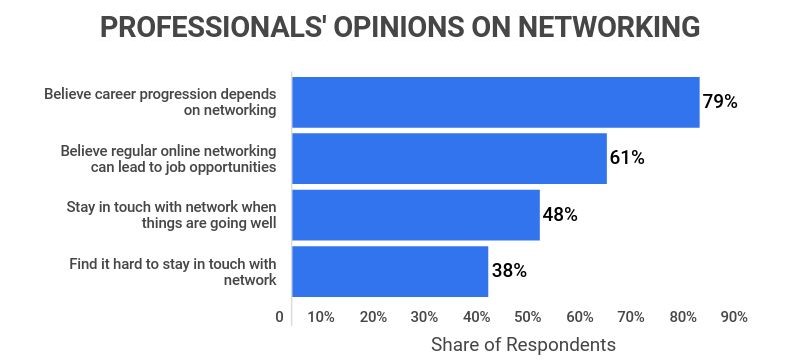
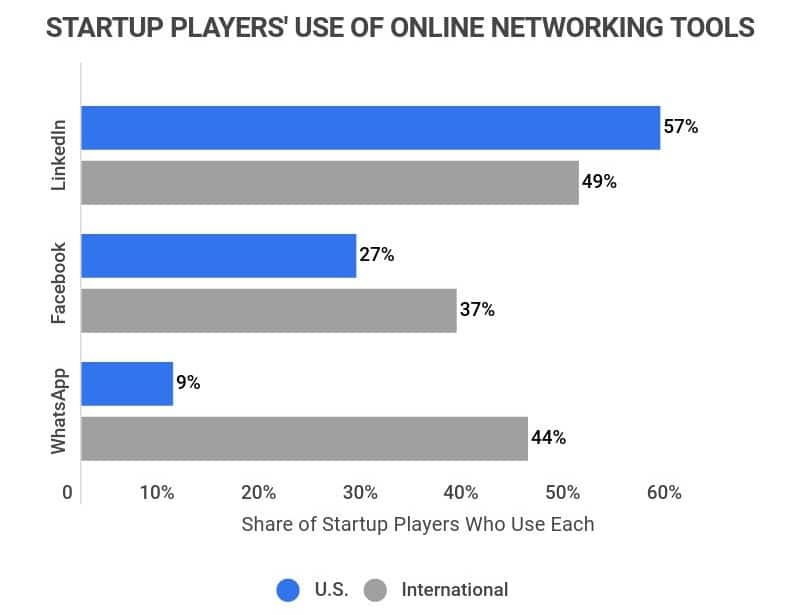
In-Person Networking Statistics
We’ve explored some of the benefits of in-person networking, but this section will address the topic in more detail. Here are the facts:
-
It’s important to maintain eye contact 50% of the time when speaking and 70% of the time when listening.
Eye contact is a valuable way of showing that you’re interested in a conversation. Establish it right away, and follow the 50/70 rule. However, eye contact should only be maintained for four to five seconds.
-
55% of all communication relies on body language.
These include things like posture, eye contact, personal space, facial expressions, hand gestures, and more. Overall, only 7% of communication is verbal, 38% is vocal, and 55% is visual.
“Vocal” refers to the tone of one’s voice, while “verbal” refers to the actual content of one’s speech. In other words, up to 93% of all spoken communication is interpreted via nonverbal communication.
-
95% of professionals agree that face-to-face communication is vital for their business.
This can be attributed to the fact that 72% of people’s first impressions are influenced by handshakes. Plus, face-to-face communication is 24% more likely to result in gaining a customer.
-
Networking in person is 24% more likely to result in customers for these reasons:
Buyers and sellers get to meet, shake hands, and share ideas. Plus, body language and eye contact contribute to the overall success of communication.
-
Leisure activities are some of the best places to start networking.
It’s all about shared interests. Here are some of the best and potentially surprising places you should be networking: hobby clubs, coffee shops, retreats, classes, alumni events, online forums, job fairs, charities, and cultural events.
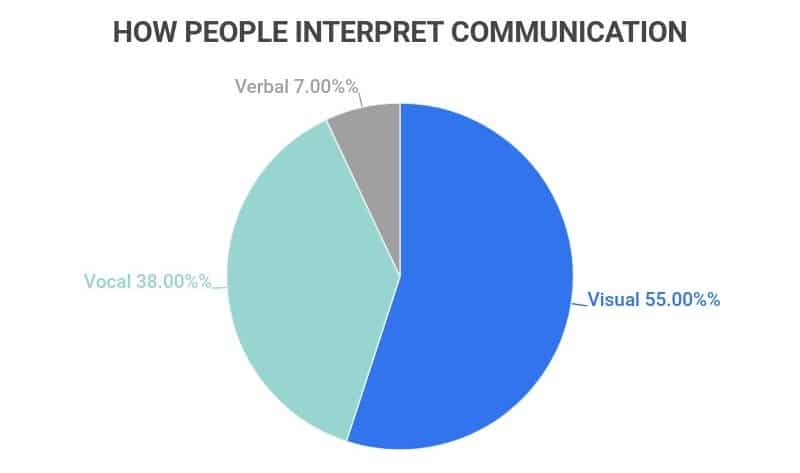
Virtual Networking Statistics
Due to the COVID-19 pandemic, many workers were forced or opted to take remote working positions. Of course, working remotely has an impact on everyone’s ability to network. Here’s what we found:
-
61% of employees prefer remote group meetings.
For large group meetings, 61% of employees prefer virtual meetings, as opposed to the 31% who don’t. These numbers are more even for small team project meetings, where only 51% preferred virtual meetings, as opposed to 49% who preferred in-person meetings.
-
49% of employees report that one of the major benefits of online networking is “easier accessibility.”
Additionally, 70% of people agreed that online networking allowed them to attend more meetings. This goes hand in hand with another benefit employees noted, as 19% said that online networking was more cost-effective.
-
40% of professionals say that they network more online than in person.
Despite in-person networking being 24% more effective, nearly half of all businesses choose to network online more than in-person.
-
35.5 million people have received a job through LinkedIn.
Overall, this professional networking website has resulted in 122 million interviews and 35.5 million hires.
-
69% of professionals prefer meeting new clients or customers in person rather than virtually.
Of all work-related activities, this is the one that employees agree the most on. The second most popular in-person preference is meeting the people you supervise, with 59% of respondents agreeing that this task is preferable in-office rather than through virtual meetings.
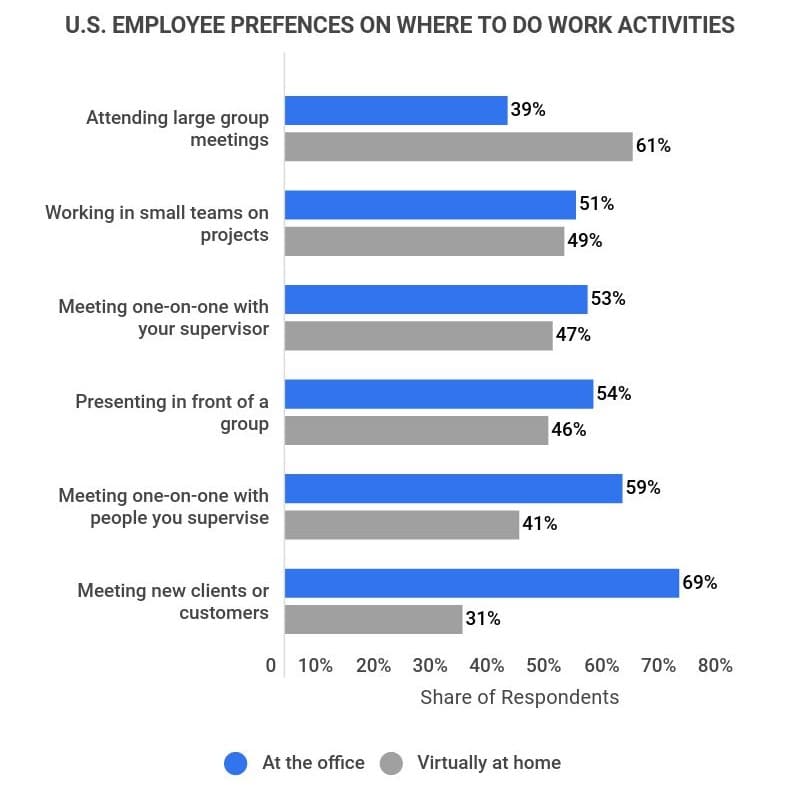
Employee Workplace Activity Preferences: In-office or Virtual
If you had to choose, would you rather do each of the following work activities in-person at your workplace or virtually, from home?
| At the Office | Virtually at Home | |
|---|---|---|
| Attending large group meetings | 39% | 61% |
| Working in small teams on projects | 51% | 49% |
| Meeting one-on-one with your | 53% | 47% |
| Presenting in front of a group | 54% | 46% |
| Meeting one-on-one with people you | 59% | 41% |
| Meeting new clients or customers | 69% | 31% |
Statistics on Networking Challenges
Despite the benefits of networking, it isn’t always easy to keep up with. If you have a hard time maintaining a network, you’re not alone. Here are the facts:
-
Only 48% of professionals say they keep in touch with their network.
And 38% say that it’s hard to keep in touch. Many struggle to maintain their network and the leading reported cause is a lack of time.
-
41% of people want to network more often.
Because 38% find it hard to keep in touch, it’s no surprise that 41% wish they would network more often.
-
Post-COVID-19, 44% of employees work from home at least some of the time.
Before the pandemic, only 17% of Americans worked from home, but now that number has risen by 27%. Because of that, online networking has become a far more viable option for professionals.
-
Cyber crime has risen by 600% since the start of the COVID-19 pandemic.
This is a huge downside of online networking as hacking, phishing, scams, and other issues can make it difficult to network effectively. For big networking teams, maintaining cyber security can be a costly endeavor.
Networking Statistics by Demographics
Curious to know more about when to network or important networking demographics? These are the detailed statistics for where, when, and who to network with:
-
38% of American small business owners say that bars and restaurants are places where they typically network.
Bars and restaurants come second to “community functions,” which 48% of SBOs find to be the best place to networking. Still, it’s a fact that the greatest majority of small business owners, 70%, networking online via social media.
Other interesting and common networking locations include the gym (23%), on an airplane (17%), and during a daily commute (28%). Truly, the opportunities for networking are all around us in our daily lives.
-
93% of Millennials own a smartphone, as opposed to only 68% of Baby Boomers.
The fact that Millenials own more smartphones, laptops, and tablets, as well as access the internet and social media more often, means that online networking is more effective for them. For example, Facebook is used by 37% of entrepreneurs, but only 60% of Baby Boomers use it, compared to 84% of Millennials.
-
Most of LinkedIn’s users are between the ages of 25 and 34.
60% of LinkedIn’s total users are in this age range. 18- to 24-year-olds make up the next largest segment at 21.7%.
Where American Small Business Owners Network
| Location | Share Of Small Business Owners Who Network There |
|---|---|
| Online (via social media) | 70% |
| Parties/social events | 51% |
| Conferences (net) | 49% |
| Local conferences | 40% |
| National conferences | 25% |
| International conferences | 10% |
| Community functions | 48% |
| Volunteer functions | 37% |
| Industry functions | 37% |
| Bars or restaurants | 38% |
| Daily commute | 28% |
| Gym | 23% |
| Airplane | 17% |
| Other | 10% |
| Don’t network | 6% |
Professional Networking Statistics FAQ
-
The best way to improve your network is to reach out and get involved with your community. This includes going to social events, complimenting people, asking questions, finding common interests, using social media, taking a mental note of who you meet, following up after meetings, and making yourself a resource for other people.
If you want to improve your network, you’re not alone. Only 48% of professionals say they keep in touch with their network, and 38% say it’s hard to do so. However, you can make networking easy by reading this guide on how to network.
-
Should I network online or in-person?
You should network in-person when possible, but online networking is also effective. There are benefits to both networking online and in person. Of course, statistics show that businesses are 24% more likely to gain new customers through in-person networking. However, this should not discourage you from online networking.
Post pandemic, more Americans are working remotely than ever before, and trends show that younger generations prefer online networking. When in doubt, consider what you need to network for. What kind of demographics do you need to attract? That will determine whether or not you need more of an online or in-person focus.
-
How effective is networking?
Networking is extremely effective for finding job opportunities, developing your knowledge and skill set, and staying up-to-date on news in your industry. Up to 85% of jobs are filled through networking rather than traditional online job boards, meaning that a strong network is your best chance of having a full slate of career options available to you.
To ensure that networking is effective, make sure that you’re intentional and deliberate about the relationships you build, especially as you’re just getting started. Always consider how you can be valuable to other people, rather than thinking of networking as a one-way street of people doing you favors.
-
Why is networking so hard?
Networking is so hard because the attitude that most people have toward networking is one of fear or even disgust. It’s easy to think of networking as the type of thing reserved for old businessmen in Las Vegas convention centers, but the truth is that professional networking isn’t all that different from personal relationship-building.
The underlying assumption behind this attitude is that networking is a way of getting an unfair advantage by “knowing the right people,” which flies in the face of Americans’ love and belief in meritocracy.
However, all industries from the dawn of civilization have relied on personal relationships to succeed, so, whether you like it or not, knowing people is part of building a career.
Finally, networking is so hard because it often requires talking to new people, putting your ideas out there, and engaging with other people’s ideas in a respectful and thoughtful way — all things that require varying degrees of energy depending on your personality type.
To make networking less hard, don’t put so much pressure on the relationships you’re trying to build. It may take some practice, but try to shift your attitude away from networking as an unpleasant necessity and towards active excitement about getting to know more people who share your passions and aspirations.
Conclusion
While networking isn’t always easy, as shown by 38% of people outright saying it’s hard, it’s nevertheless important. 70% of people got their current job through networking, and a massive 80% of jobs available aren’t even listed on job sites. Additionally, in-person and online networking accounts for 16-40% of all customers gained.
Whether you’re looking for a new job or new customers, networking plays a vital role in your success. So, knowing that, it’s important to maintain your network. Use social media apps like LinkedIn or Facebook to get started.
References
-
CNBC. “How to get a job often comes down to one elite personal asset, and many people still don’t realize it’’. Accessed on August 11, 2021
-
Payscale. “HOW MANY JOBS ARE FOUND THROUGH NETWORKING, REALLY?’’. Accessed on August 11, 2021
-
The New York times. “Small Meetings, Big Pluses’’. Accessed on August 11, 2021
-
Progressive Grocer. “Consumers Still Prefer In-Store Shopping’’. Accessed on August 11, 2021
-
Small Business Trends. “72 Percent Will Judge Your Company by the Quality of Your Business Card (INFOGRAPHIC)’’. Accessed on August 11, 2021
-
Linkedin. “Eighty-percent of professionals consider networking important to career success’’. Accessed on August 11, 2021
-
Chicago booth review. “The network is an entrepreneur’s best asset’’. Accessed on August 11, 2021
-
Forbes. “Face-To-Face Is Still Best For Networking And Dealmaking, So What’s Your Conference Strategy For 2016?’’. Accessed on August 11, 2021
-
Michigan State University. “Eye contact: Don’t make these mistakes”. Accessed on August 11, 2021
-
Lifesize. “Nonverbal Communication: How Body Language Nonverbal Cues Are Key”. Accessed on August 11, 2021
-
Business Pundit. “25 Best Places to Network’’. Accessed on August 11, 2021
-
Zoom. “New Survey: What People Really Think about Hybrid Work”. Accessed on August 11, 2021
-
Nature. “Online collaboration: Scientists and the social network’’. Accessed on August 11, 2021
-
Kinsta. “Mind-Blowing LinkedIn Statistics and Facts (2021)’’. Accessed on August 11, 2021
-
Statista. “Change in remote work trends due to COVID-19 in the United States in 2020”. Accessed on August 11, 2021
-
Purplesec. “2021 Cyber Security Statistics The Ultimate List Of Stats, Data Trends”. Accessed on August 11, 2021
-
Undercover recruiter. “Why Employee Referrals are the Best Source of Hire”. Accessed on August 11, 2021
-
Pew research center. “Millennials stand out for their technology use, but older generations also embrace digital life”. Accessed on August 11, 2021
-
CoSchedule. “What 14 Studies Say About The Best Time To Send Email”. Accessed on August 11, 2021
-
Ipsos. “Business Card/Networking Study”. Accessed on February 8, 2022.
-
DataReportal. “LinkedIn Statistics and Trends”. Accessed on February 23, 2023.
- Job Seeker Statistics
- Career Change statistics
- Internship Statistics
- Job Search Statistics
- Average Number Of Jobs Applied
- Average Salary Increase When Changing Jobs
- Part Time Job Statistics
- Age Discrimination Statistics
- Networking Statistics
- Interview Statistics
- Average Number of Jobs In A Lifetime
- Resume Statistics
- Side Hustle Statistics
- Teacher Statistics








